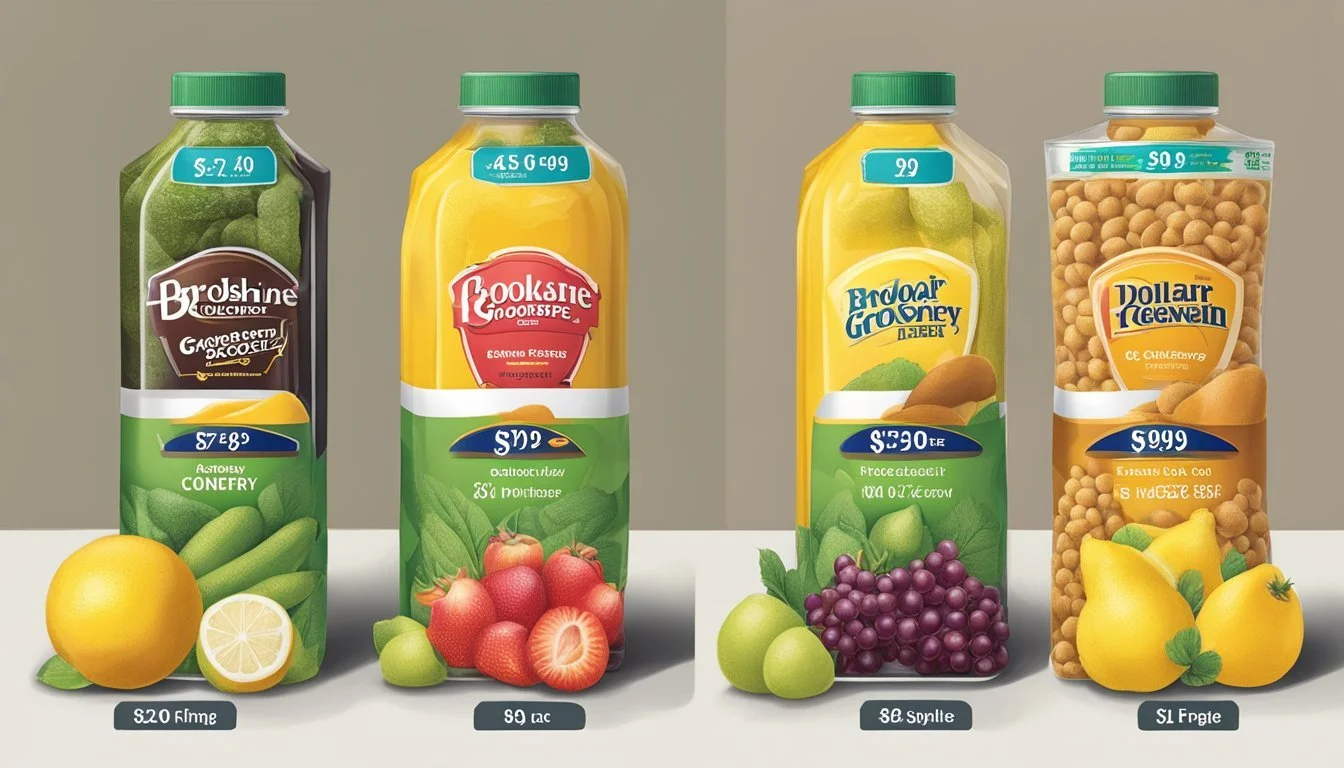Is Brookshire Grocery Company Cheaper Than Dollar General?
A Price Comparison Analysis
Brookshire Grocery Company and Dollar General are two prominent retail chains in the United States, each serving a distinct segment of the market. While Brookshire's operates over 200 grocery stores across Texas, Louisiana, Arkansas, and Oklahoma, Dollar General has a much larger national presence with thousands of discount stores.
Generally, Dollar General offers lower prices on many items compared to traditional grocery stores like Brookshire's. This is due to Dollar General's focus on providing basic necessities and household goods at discounted rates. However, the comparison isn't always straightforward.
Brookshire's provides a wider selection of fresh produce, meats, and specialty items that may not be available at Dollar General. The grocery chain also offers higher-end products and services that cater to a different customer base. While shoppers might find better deals on certain products at Dollar General, Brookshire's competitive pricing and broader range of options make it a preferred choice for many consumers doing their regular grocery shopping.
Overview of Brookshire Grocery Company
Brookshire Grocery Co. (BGC) is a regional grocery chain founded in 1928 in Tyler, Texas. The company operates over 200 stores across four states: Texas, Louisiana, Arkansas, and Oklahoma.
BGC runs several store brands, including:
Brookshire's
Super 1 Foods
Fresh by Brookshire's
Spring Market
The company's headquarters remain in Tyler, Texas, where it began as a small 2,500-square-foot store on the courthouse square.
BGC employs thousands of workers across its retail locations and distribution centers. The company operates four distribution facilities to supply its stores efficiently.
Known for friendly service and clean stores, BGC has embraced technological innovation throughout its history. This approach has helped the company grow from a single location to a major regional player in the grocery industry.
The company remains family-owned, continuing the legacy of its founder Wood T. Brookshire. BGC's commitment to its communities is evident through various charitable initiatives and local partnerships.
Analysis of Pricing Strategies
Pricing strategies play a crucial role in the competitive landscape of grocery retail. Both Brookshire Grocery Company and Dollar General employ distinct approaches to attract and retain customers.
Competitive Landscape
The grocery retail market is highly competitive, with numerous players vying for market share. Walmart, Kroger, and Albertsons dominate the national scene, while regional chains like H-E-B and Aldi maintain strong local presences. Discount retailers like Dollar General have carved out a niche by focusing on low prices and convenience.
Brookshire Grocery Company faces competition from larger national chains as well as regional players like Brookshire Brothers and Reasor's. To stay competitive, grocery retailers must carefully balance pricing, product quality, and customer service.
Many chains use a mix of pricing strategies, including loss leaders, volume discounts, and everyday low prices. Some, like Sprouts Farmers Market and Natural Grocers, focus on organic and specialty products to differentiate themselves from discount-oriented competitors.
Brookshire's Pricing Approach
Brookshire Grocery Company employs a competitive pricing strategy, aiming to offer value while maintaining product quality. The company likely conducts regular market analyses to ensure its prices remain attractive to customers.
Brookshire's may use a cost-plus pricing model for some items, adding a markup to the wholesale cost. For other products, they might adopt a value-based approach, setting prices based on perceived customer value.
The company likely offers promotional pricing on select items to drive store traffic. This could include weekly specials, loyalty program discounts, and seasonal promotions.
Brookshire's pricing strategy must account for its diverse product mix, which includes both national brands and private label offerings. Private label products often allow for higher profit margins while still providing customers with lower-priced alternatives.
Dollar General's Pricing Model
Dollar General is known for its aggressive pricing strategy, focusing on offering products at rock-bottom prices. The company's business model is built around providing everyday essentials at low costs.
To maintain low prices, Dollar General employs several tactics:
Limited product selection
Smaller store formats
Emphasis on private label brands
Efficient supply chain management
Dollar General often uses a psychological pricing strategy, setting prices just below round numbers (e.g., $0.99 or $1.99) to create the perception of better value.
The company's low-price image is reinforced through consistent marketing messages and in-store signage highlighting deals and savings. Dollar General also offers promotional pricing on select items to drive customer traffic and encourage impulse purchases.
Product and Service Differentiation
Brookshire Grocery Company and Dollar General employ distinct strategies to attract customers. Their approaches differ in product selection, store ambiance, and customer interactions.
Range of Products
Brookshire Grocery Company offers a wide array of products, including fresh produce, meats, dairy, and deli items. Their stores typically stock a larger selection of organic and healthy options compared to Dollar General. Brookshire's focus on fresh foods sets them apart, with dedicated sections for fruits, vegetables, and high-quality meats.
Dollar General, in contrast, emphasizes convenience items and non-perishables. Their stores stock basics like light bulbs, laundry detergent, and milk at competitive prices. While they may offer some frozen foods and limited fresh items, their selection is not as extensive as Brookshire's.
Store Experience
Brookshire Grocery Company stores are often larger and designed to create a pleasant shopping environment. Their layouts are spacious, with wide aisles and clear signage. Many locations feature modern fixtures and bright lighting to enhance the shopping experience.
Dollar General stores are typically smaller and more compact. Their design prioritizes efficiency and quick shopping trips. Aisles may be narrower, and the overall aesthetic is more functional than inviting.
Customer Service
Brookshire Grocery Company places a strong emphasis on customer service. Their staff are often trained to be knowledgeable about products and assist shoppers with questions or special requests. Many locations offer additional services like custom meat cutting or special orders.
Dollar General's approach to customer service is more streamlined. While staff are generally helpful, the focus is on maintaining low prices and quick transactions. Self-checkout options are common in Dollar General stores to enhance efficiency.
Economic Factors and Market Presence
Brookshire Grocery Company's economic impact and market presence are shaped by its revenue, growth patterns, and strategic expansion efforts across multiple states.
Revenue and Growth Patterns
Brookshire Grocery Company operates over 200 stores across Texas, Louisiana, Arkansas, and Oklahoma. As a privately held company, specific revenue figures are not publicly disclosed. However, the company's recent acquisition of Reasor's Markets in Oklahoma indicates strong financial health and a focus on expansion. This move added 17 new locations to Brookshire's portfolio, significantly increasing its market presence in the region.
The company maintains four distribution centers to support its growing network of stores. These facilities play a crucial role in managing inventory and ensuring efficient supply chain operations across Brookshire's multi-state footprint.
Market Penetration Strategy
Brookshire Grocery Company employs a targeted market penetration strategy, focusing on both urban and rural areas. In East Texas, where the company originated, Brookshire maintains a strong presence in cities like Tyler and Longview. The company has also expanded into larger metro areas, including stores in Plano, Allen, and McKinney near Dallas.
Smaller markets are not overlooked, with locations in towns like Corsicana, Granbury, Palestine, and Rockwall. This diverse approach allows Brookshire to serve a wide range of communities and compete effectively against both regional and national chains.
The acquisition of Reasor's demonstrates Brookshire's commitment to growth through strategic purchases, enabling rapid entry into new markets and strengthening its competitive position in the grocery industry.
Brand Image and Customer Perceptions
Brookshire Grocery Company has cultivated a reputation as a family-owned business with strong community ties. This image resonates with many shoppers who value supporting local enterprises.
The company's emphasis on healthy and delicious food options, particularly through its Food Club and Goldenbrook private labels, appeals to health-conscious consumers. These brands offer quality products at competitive prices.
Brookshire's community involvement initiatives have helped build brand loyalty. Their support for local causes and events strengthens their connection with customers beyond just retail transactions.
In contrast, Dollar General is often perceived as a no-frills discount retailer. While this attracts price-sensitive shoppers, it may not align with those seeking a more upscale grocery experience.
Customer perceptions of Brookshire's tend to focus on freshness and quality, especially in produce and meat departments. This can justify slightly higher prices for some shoppers who prioritize these attributes.
Brand loyalty to Brookshire's is often rooted in its long-standing presence in many communities. Generations of families have shopped at Brookshire's stores, creating an emotional connection to the brand.
Both companies cater to different market segments, with Brookshire's appealing more to those seeking a full-service grocery experience and Dollar General targeting extreme value seekers.
Operational Efficiencies and Innovations
Brookshire Grocery Company has implemented various strategies to enhance its operational efficiency and drive innovation. These efforts span supply chain improvements, technological advancements, and sustainability initiatives.
Supply Chain Optimization
Brookshire Grocery Company operates three distribution centers to serve its 209 stores across Texas, Louisiana, Arkansas, and Oklahoma. The company has streamlined its supply chain processes to reduce costs and improve product availability. It utilizes data-driven forecasting to optimize inventory levels and minimize waste.
Brookshire's distribution network employs cross-docking techniques to expedite product flow from suppliers to stores. This approach reduces warehouse storage needs and accelerates stock replenishment. The company has also invested in automated sorting systems to enhance accuracy and speed in order fulfillment.
Partnerships with local suppliers help shorten supply chains and ensure fresher products reach store shelves. This strategy supports regional economies while reducing transportation costs and environmental impact.
Technological Advancements
Brookshire Grocery Company has embraced technology to improve operational efficiency. The retailer recently implemented Logile's comprehensive retail labor planning and workforce management solutions across all its locations. This system optimizes staff scheduling and task management, leading to improved productivity and customer service.
In-store innovations include self-checkout kiosks and mobile payment options to reduce wait times. Brookshire's has also developed a mobile app that offers digital coupons and personalized promotions, enhancing the shopping experience and driving customer loyalty.
The company utilizes advanced analytics to inform pricing strategies and product placement decisions. This data-driven approach helps maximize sales and reduce stock-outs.
Sustainability Initiatives
Brookshire Grocery Company has implemented several sustainability measures to reduce its environmental footprint and cut operational costs. Energy-efficient lighting and refrigeration systems have been installed in stores and distribution centers, significantly lowering electricity consumption.
The company has initiated recycling programs for cardboard, plastics, and food waste. These efforts divert a substantial amount of waste from landfills and contribute to a circular economy.
Brookshire's has also invested in fuel-efficient delivery trucks and optimized routing systems. These changes have reduced fuel consumption and emissions associated with product distribution.
Water conservation measures, including low-flow fixtures and drought-resistant landscaping, have been implemented across the company's facilities. These initiatives align with Brookshire's commitment to responsible resource management.
Conclusion
Brookshire Grocery Company and Dollar General offer distinct shopping experiences for consumers. Brookshire's focuses on full-service supermarkets with a wider range of products and specialty departments. Dollar General emphasizes discount prices on a more limited selection of everyday essentials.
Price comparisons between the two retailers can vary significantly by specific item and location. Dollar General often has lower prices on packaged goods and household items. Brookshire's may be more competitive on fresh produce, meats, and store-brand products.
For budget-conscious shoppers, Dollar General provides opportunities for savings on many common household goods. Brookshire's offers a broader shopping experience with more product variety and services like pharmacies and prepared foods.
The retail grocery landscape continues to evolve with shifting consumer preferences. Both companies adapt their strategies to meet local market needs. Ultimately, the "cheaper" option depends on individual shopping habits, product preferences, and priorities.
Consumers benefit from having choices in their local grocery options. Comparison shopping and taking advantage of sales at both stores can help maximize savings. The competition between different grocery formats keeps pressure on prices across the industry.









